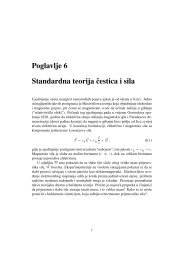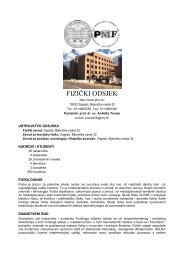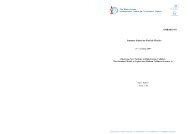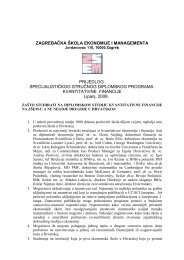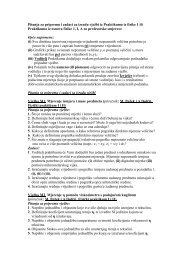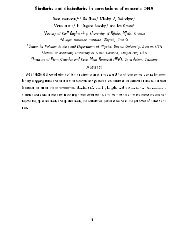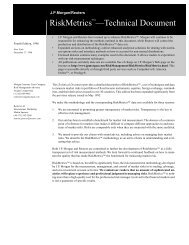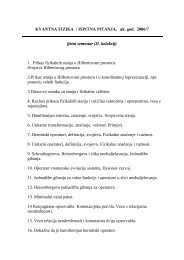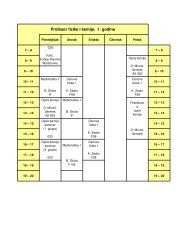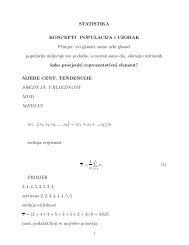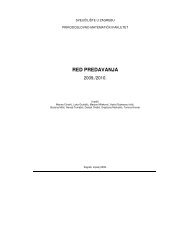RiskMetrics⢠âTechnical Document
RiskMetrics⢠âTechnical Document
RiskMetrics⢠âTechnical Document
Create successful ePaper yourself
Turn your PDF publications into a flip-book with our unique Google optimized e-Paper software.
56 Chapter 4. Statistical and probability foundations<br />
In Charts 4.6 and 4.7 we also notice not only the individual volatility clustering, but the correlation<br />
of the clusters between return series. For example, note that periods of high volatility in<br />
USD/DEM returns coincide with high volatility in USD/FRF returns. Such correlation between<br />
returns series motivates the development of multivariate models, that is, models of returns that<br />
measure not only individual series variance (volatility), but also the correlation between return<br />
series.<br />
4.3.2 Are returns statistically independent over time?<br />
Having established, albeit informally, the possibility of time-varying variances, and consequently,<br />
a violation of the identically distributed assumption, we now investigate the validity of the independence<br />
assumption, i.e., the second assumption of IID. From our methods and the data that we<br />
present in the following sections (4.3.2.1 through 4.3.2.3), we conclude that returns in a given<br />
series are not independent of each other.<br />
In Charts 4.6 and 4.7, the persistence displayed by the volatility clusters shows some evidence of<br />
autocorrelation in variances. That is, the variances of the series are correlated across time. If<br />
returns are statistically independent over time, then they are not autocorrelated. Therefore, a natural<br />
method for determining if returns are statistically independent is to test whether or not they are<br />
autocorrelated. In order to do so, we begin by defining correlation and a method of testing for<br />
autocorrelation.<br />
4.3.2.1 Autocorrelation of daily log price changes<br />
For a given time series of returns, the autocorrelation coefficient measures the correlation of<br />
returns across time. In general, the standard correlation coefficient between two random variables<br />
X and Y is given by the covariance between X and Y divided by their standard deviations:<br />
[4.23]<br />
ρ xy<br />
=<br />
2<br />
σ xy<br />
-----------<br />
σ x<br />
σ y<br />
2<br />
σ xy<br />
where represents the covariance between X and Y. A simple way to understand what covariance<br />
measures is to begin with the definition of variance. The variance of a random variable X is a<br />
measure of the variation of X around its mean, . The mathematical expression for variance is<br />
µ X<br />
[4.24]<br />
E ( X – µ X<br />
) 2<br />
where the term E[ ] is the mathematical expectation—or more simply, the average. Whereas the<br />
variance measures the magnitude of variation of one random variable (in this case X), covariance<br />
measures the covariation of two random variables (say, X and Y). It follows that if the variance of<br />
X is the expected value of ( X – µ X<br />
) times ( X – µ X<br />
) , then the covariance of X and Y is the<br />
expected value of ( X – µ X<br />
) times ( Y – µ Y<br />
) , or<br />
[4.25]<br />
E[ ( X – µ X<br />
) ( Y – µ Y<br />
)]<br />
Now, for a time series of observations r t<br />
, t = 1…T , the kth order autocorrelation coefficient ρ(k)<br />
is defined as:<br />
[4.26]<br />
2<br />
,<br />
2<br />
σ t t<br />
2<br />
σ t<br />
σ<br />
ρ t t – k<br />
k<br />
= ---------------- = -------------- , – k<br />
σ t<br />
σ t – k<br />
RiskMetrics —Technical <strong>Document</strong><br />
Fourth Edition



